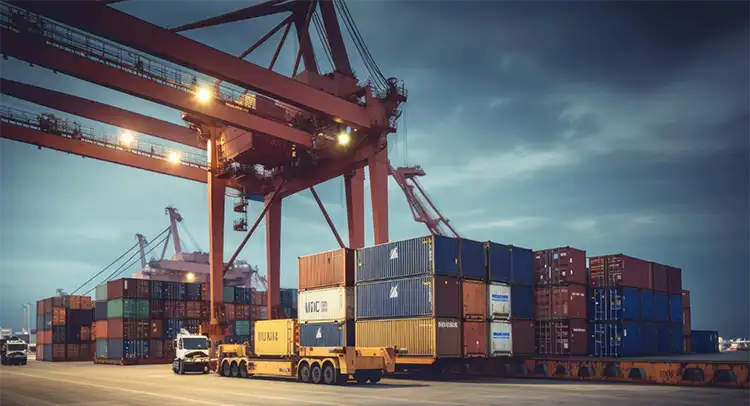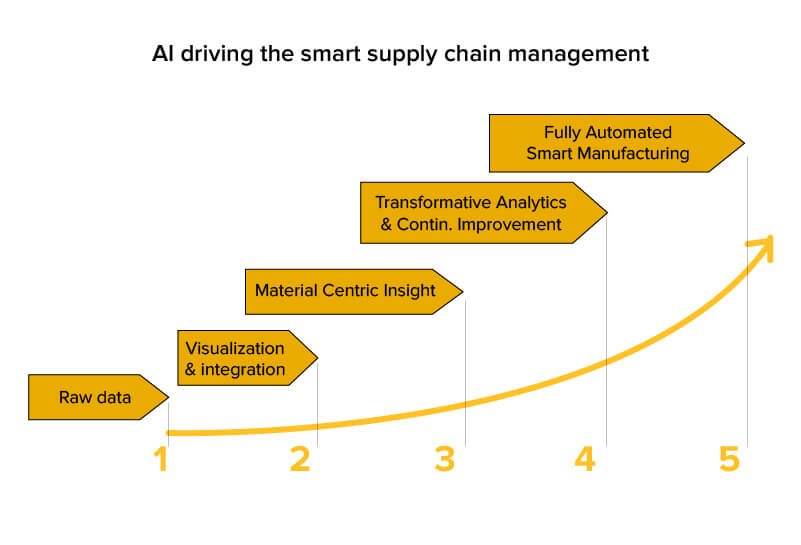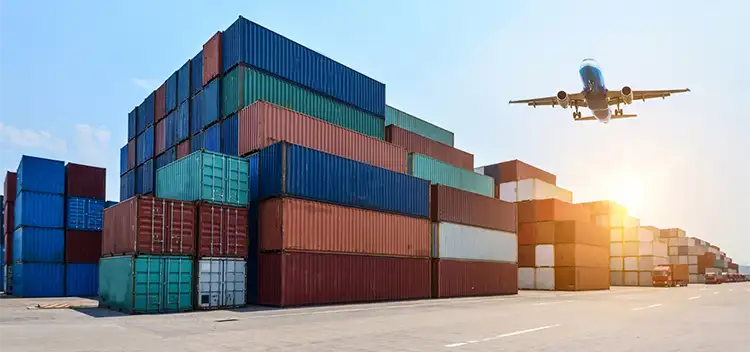
In today’s fast-paced and ever-changing business landscape, companies are constantly seeking ways to improve their supply chain operations. One area that has gained significant attention is supply chain visibility. By having a clear view of their entire supply chain, companies can make informed decisions, enhance efficiency, and ensure customer satisfaction. And now, with the advent of AI-driven solutions, the possibilities for improving supply chain visibility are endless.
Imagine having a virtual assistant that can analyze massive amounts of data in real-time, identify patterns, and provide actionable insights to optimize your supply chain processes. That’s exactly what AI-driven solutions bring to the table. With advanced algorithms and machine learning capabilities, these solutions can monitor every step of the supply chain, from procurement to delivery, and identify potential bottlenecks or inefficiencies. By harnessing the power of AI, companies can proactively address issues, streamline operations, and ultimately deliver a seamless customer experience.
When it comes to optimizing supply chain visibility, AI-driven solutions are the game-changer that companies have been waiting for. By leveraging the power of artificial intelligence, businesses can gain a competitive edge, improve operational efficiency, and enhance customer satisfaction. In the next sections, we will explore some of the key benefits and applications of AI-driven solutions in the context of supply chain visibility. So, buckle up and get ready to embark on a journey where technology meets logistics, and innovation paves the way for success.
Improving Supply Chain Visibility with AI-driven Solutions
Enhancing supply chain visibility is crucial for businesses looking to streamline operations and reduce costs. AI-driven solutions offer a powerful tool to achieve this goal. By leveraging advanced analytics and machine learning algorithms, these solutions enable real-time tracking of inventory, predictive demand forecasting, and proactive issue resolution. With AI, businesses can gain valuable insights into their supply chain, identify bottlenecks, and optimize logistics processes. This not only improves efficiency but also enhances customer satisfaction by ensuring timely deliveries. Embracing AI-driven solutions is a game-changer for businesses seeking to stay competitive in today’s fast-paced global market.

Improving Supply Chain Visibility with AI-driven Solutions
The supply chain is a complex network of interconnected processes and activities that involve the movement of goods and services from the point of origin to the point of consumption. In today’s globalized world, supply chains have become longer and more intricate, making it challenging for businesses to have complete visibility and control over their operations. However, with the advent of AI-driven solutions, companies now have the opportunity to enhance their supply chain visibility and optimize their processes for improved efficiency and customer satisfaction.
The Role of AI in Supply Chain Visibility
AI, or Artificial Intelligence, refers to the simulation of human intelligence in machines that are programmed to think and learn like humans. When applied to the supply chain, AI can analyze vast amounts of data, identify patterns, and make predictions to optimize operations and enhance visibility. By leveraging AI-driven solutions, businesses can gain real-time insights into their supply chain processes, enabling them to make informed decisions and take proactive measures to address any issues that may arise.
AI can help improve supply chain visibility in several ways. Firstly, it can automate data collection and analysis, eliminating the need for manual tracking and reducing the risk of human error. AI-powered algorithms can process data from various sources, such as sensors, IoT devices, and historical records, to provide accurate and up-to-date information on inventory levels, production status, and transportation routes. This real-time visibility allows businesses to identify bottlenecks, forecast demand, and optimize their supply chain operations for maximum efficiency.
The Benefits of AI-driven Solutions for Supply Chain Visibility
Implementing AI-driven solutions in the supply chain can bring a wide range of benefits for businesses. Firstly, it enables enhanced demand forecasting, allowing companies to predict customer demand more accurately. By analyzing historical data and considering factors such as seasonality, market trends, and customer behavior, AI algorithms can generate accurate demand forecasts, helping businesses optimize inventory levels and avoid stockouts or overstocking.
Secondly, AI can improve inventory management by providing real-time visibility into stock levels and locations. By integrating AI with IoT devices and sensors, companies can track the movement of goods throughout the supply chain, ensuring that inventory is always available when and where it is needed. This reduces the risk of stockouts and enables businesses to optimize their inventory holding costs.

Furthermore, AI-driven solutions can enhance supply chain collaboration and communication. By providing a centralized platform for sharing information and insights, AI enables seamless collaboration between suppliers, manufacturers, distributors, and retailers. This improves coordination, reduces lead times, and ensures that all parties have access to accurate and up-to-date information, leading to smoother operations and better customer service.
In conclusion, AI-driven solutions have the potential to revolutionize supply chain visibility by providing real-time insights, accurate forecasting, and enhanced collaboration. By leveraging AI technologies, businesses can optimize their supply chain processes, reduce costs, and improve customer satisfaction. As the global business landscape continues to evolve, embracing AI-driven solutions will be crucial for staying competitive and thriving in the ever-changing marketplace.
Key Takeaways: Improving Supply Chain Visibility with AI-driven Solutions
- Artificial Intelligence (AI) can help companies track and monitor their supply chains more effectively.
- AI-driven solutions provide real-time insights and analytics, enabling businesses to make informed decisions.
- Improved visibility allows companies to identify and address potential bottlenecks or disruptions in the supply chain.
- AI can optimize inventory management, reducing costs and improving efficiency.
- With AI, companies can enhance forecasting accuracy, minimizing stockouts and overstock situations.
Frequently Asked Questions
How can AI-driven solutions improve supply chain visibility?
AI-driven solutions have the capability to revolutionize supply chain visibility by providing real-time insights and predictive analytics. By leveraging advanced algorithms and machine learning, these solutions can analyze vast amounts of data from various sources, such as IoT devices, sensors, and historical data, to identify patterns, predict demand fluctuations, and optimize inventory levels. This enables organizations to have a holistic view of their supply chain operations and make data-driven decisions to improve efficiency and reduce costs.
Furthermore, AI-driven solutions can automate and streamline processes, such as demand forecasting, inventory management, and order fulfillment. This not only reduces human error but also increases accuracy and speed, resulting in improved supply chain visibility. With AI, organizations can proactively identify bottlenecks, forecast potential disruptions, and take proactive measures to mitigate risks, ensuring smooth operations and better customer satisfaction.
What are the benefits of improving supply chain visibility with AI?
Improving supply chain visibility with AI-driven solutions brings several benefits to organizations. Firstly, it enhances operational efficiency by providing real-time insights into inventory levels, demand patterns, and production capacities. This enables organizations to optimize their supply chain processes, reduce lead times, and improve overall productivity.
Secondly, AI-driven solutions help organizations minimize costs by optimizing inventory levels and reducing wastage. By accurately predicting demand fluctuations and optimizing reorder points, organizations can avoid overstocking or stockouts, resulting in significant cost savings.
Another key benefit is improved customer satisfaction. With AI-driven solutions, organizations can ensure timely delivery of products, manage customer expectations, and provide proactive updates on order status. This leads to higher customer loyalty and positive brand perception.
Lastly, AI-driven solutions enable organizations to proactively identify and mitigate risks. By analyzing historical data and external factors, such as weather conditions or geopolitical events, AI can identify potential disruptions and help organizations take preventive measures to minimize their impact.
How does AI-powered predictive analytics improve supply chain visibility?
AI-powered predictive analytics leverages machine learning algorithms to analyze historical and real-time data, identify patterns, and forecast future outcomes. In the context of supply chain visibility, this technology can accurately predict demand fluctuations, production capacities, and inventory levels.
By analyzing historical sales data, market trends, and external factors, AI-powered predictive analytics can forecast future demand with a high level of accuracy. This enables organizations to optimize inventory levels, reduce stockouts, and avoid overstocking, resulting in improved supply chain visibility.

Furthermore, predictive analytics can identify potential bottlenecks and risks in the supply chain. By analyzing data from various sources, such as transportation routes, supplier performance, and weather conditions, AI-powered predictive analytics can proactively identify potential disruptions and help organizations take preventive measures to mitigate risks. This enhances supply chain visibility by enabling organizations to address issues before they occur and ensure smooth operations.
What challenges can organizations face when implementing AI-driven solutions for supply chain visibility?
While AI-driven solutions offer numerous benefits, organizations may face certain challenges when implementing them for supply chain visibility. One challenge is data integration and quality. AI relies on data to provide accurate insights and predictions. Therefore, organizations need to ensure that the data from different sources, such as ERP systems, IoT devices, and sensors, is integrated and of high quality. This requires robust data management processes and systems.
Another challenge is the initial investment and infrastructure required for AI implementation. Organizations need to allocate resources for acquiring AI technologies, training AI models, and setting up the necessary infrastructure. Additionally, organizations may need to upgrade their existing systems and processes to accommodate AI-driven solutions.
Furthermore, organizations may encounter resistance from employees during the implementation phase. AI-driven solutions may automate certain tasks, which can lead to concerns about job security or the need for reskilling. Organizations need to address these concerns through proper communication and training programs to ensure smooth adoption.
How can organizations overcome the challenges of implementing AI-driven solutions for supply chain visibility?
To overcome the challenges of implementing AI-driven solutions for supply chain visibility, organizations can take several steps. Firstly, they should prioritize data integration and quality. This involves investing in robust data management systems, establishing data governance policies, and ensuring data accuracy and consistency across different sources. Organizations can also consider partnering with third-party data providers to supplement their internal data.
Secondly, organizations should carefully plan and allocate resources for AI implementation. This includes budgeting for AI technologies, infrastructure, and training programs. It is crucial to assess the ROI of AI-driven solutions and prioritize their implementation based on the potential benefits and impact on supply chain visibility.
Moreover, organizations should focus on change management and employee engagement. By communicating the benefits of AI-driven solutions and providing training programs, organizations can alleviate fears and build a culture of trust and collaboration. Involving employees in the implementation process and addressing their concerns can lead to smoother adoption and successful integration of AI-driven solutions.
Lastly, organizations can consider starting with pilot projects or proof-of-concepts to test the feasibility and benefits of AI-driven solutions before scaling up. This allows organizations to assess the effectiveness of these solutions in improving supply chain visibility and make necessary adjustments before full implementation.

Final Thoughts: Revolutionizing Supply Chain Visibility with AI-driven Solutions
In a world where supply chains are becoming increasingly complex and interconnected, the need for enhanced visibility is paramount. The advancements in AI-driven solutions have revolutionized the way businesses manage their supply chains, providing real-time insights and predictive analytics that optimize operations and drive efficiency. By harnessing the power of artificial intelligence, organizations can now navigate through the challenges of global logistics with ease and confidence.
One of the key benefits of AI-driven solutions is the ability to collect and analyze vast amounts of data from multiple sources. This data can include information on inventory levels, transportation schedules, production processes, and customer demand. By leveraging AI algorithms, businesses can gain valuable insights into their supply chain operations, identifying bottlenecks, predicting potential disruptions, and making informed decisions in real-time. This level of visibility enables proactive measures to be taken, such as adjusting production schedules, reallocating resources, or rerouting shipments, to ensure a seamless flow of goods from suppliers to customers.
Furthermore, AI-driven solutions empower businesses to achieve greater accuracy and efficiency in their supply chain processes. Through automation and machine learning capabilities, these solutions can streamline tasks such as demand forecasting, inventory management, and order fulfillment. By accurately predicting demand patterns and optimizing inventory levels, organizations can avoid overstocking or stockouts, resulting in cost savings and improved customer satisfaction. Additionally, AI can optimize routes and transportation modes, reducing lead times and minimizing transportation costs. The integration of AI-driven solutions into supply chain management not only enhances visibility but also enables businesses to deliver products faster, at a lower cost, and with greater precision.
In conclusion, the integration of AI-driven solutions into supply chain management has transformed the way businesses operate, offering unprecedented visibility and control over their logistics processes. By leveraging the power of AI algorithms and predictive analytics, organizations can proactively identify and address potential disruptions, optimize inventory levels, and streamline operations. The result is a more efficient and resilient supply chain that can adapt to changing market dynamics and deliver superior customer experiences. As technology continues to advance, the possibilities for improving supply chain visibility through AI-driven solutions are limitless, paving the way for a future of enhanced efficiency and success in the global marketplace.



